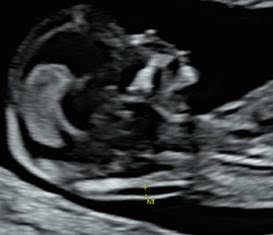Expectations about obstetric ultrasound scans have often been debated, writes Donna White, Lead Sonographer, Obstetrics and Gynaecology, East and North Hertfordshire NHS Trust (ENHT).
For some, the scan has been viewed as a bonding experience and an opportunity to share the occasion with the family. This meant that women would frequently arrive for scan with partner and children in tow with no real understanding of the complex screening procedure they consented for when they booked with a midwife in the first trimester. Others had sleepless nights prior to the scan, being fully aware of the potential outcomes and dilemmas that might cause.
Popular media tends to portray obstetric ultrasound scans as joyful events where everyone is smiling, the lights are always on and the telling of the baby’s sex plays a big part in the drama of the event. Real scans are not like this. They are quiet and serious affairs which require great concentration by the professionals involved. And while sonographers also love to share the joy of a pregnancy with their clients, sadly not every pregnancy is a joy, not every scan is a happy occasion. NHS funded scans are purposeful, scientific and diagnostic. Thus, a balance must be struck.
Balance challenging emotions
Most sonographers in obstetric ultrasound have excellent communication skills and are able to balance the challenging emotions as they tread the tightrope between parent expectations and the complexities of providing a clinical screening service. Sonographers are used to delivering news which is received with joy or explaining findings that are life changing, uncertain, confusing and, at times, heart-breaking. While many sonographers find great fulfilment in their work, it is an extremely stressful and demanding role.
Then the Covid-19 pandemic struck. Partners and children were unable to attend, while services continued to open their doors to allow women to safely access their antenatal care. For some, the thought of attending a scan alone was unthinkable. Those with poor obstetric history, women with anxiety and there was no shortage of anxious people during the height of the pandemic.
For other women, the enforced solitude in the scan room offered a chance to listen, concentrate and interact with their healthcare professionals in a real synergy of care. For some it was a great opportunity to fully understand what the ultrasound scan was about and they were confident asking questions. For 30 minutes in their busy locked down lives, they did not have to worry about anyone but themselves and had the chance to engage with their care and their baby. What a revelation!
Maternity services came under great pressure at this time to allow partners back to scans, social media campaigns started up, MPs became involved and obstetric ultrasound had to rise to the challenge. The rustle of risk assessment paperwork was heard up and down the British Isles. Some departments started to invite partners back for selected scans, some offered cine-loops of the scan which could be captured on a mobile phone while others offered open phone calls so that partners waiting in hospital car parks could listen in.
No national position
There was no national consensus since each department was different. We had to consider many things such as staffing levels, how many isolating or vulnerable staff there were, how efficient the ventilation system was, what our digital and data protection policies were.
In our local maternity and neonatal system (LMNS), the lead sonographers in our three member Trusts began to talk and share their ideas and experiences. We stood together at meetings with the Trust executive to try to explain our unique position, while trying to facilitate the requests from service users relating to real and virtual attendance at scans.
We stayed up late listening and responding to questions from our local maternity voices partnership (MVP). The service users were unhappy about the restrictions on partner access. There was variability between the services offered on different sites, based on local risk assessment. Communications to service users were changing on a monthly basis, or more frequently, as the pandemic progressed. A joint approach was obviously the way forward.
The idea of a joint statement on expectations or ‘etiquette’, and other helpful pre-scan information before attending for an ultrasound examination, was progressed. A final statement, to be given as a leaflet at booking, has been co-produced with the lead sonographers, consultant midwives and the MVP leads. Collaboration and discussion has been essential to get the language right so that service users understand the reasons for our etiquette and allow them to get the best out of their scan experience.
Covid-19 has given us the chance to re-set our relationship with our service users, which is to everyone's benefit. It also helped collaboration within the LMNS. We hope we have come through the pandemic to a level of greater understanding.
Acknowledgements:
I would like to thank lead sonographers Steph Metcalfe and Mandie Johnson, Rose Bedford and Frankie Kilmurray, consultant Midwives at ENHT, the LMNS leads and the MVP members and the sonographers at all three NHS Trusts.
Related News
 Scotland
ScotlandNews website reveals lack of oversight and inspection of Scottish baby scan clinics
Barely 10 percent of clinics are regulated by Health Improvement Scotland, investigation s...
.jpg?width=273&height=235&ext=.jpg&width=1200&resizemode=force) Ultrasound
UltrasoundFear of the red flag
Ellen Dyer describes the process of scrutinising clinical skills when screening for Downs ...
